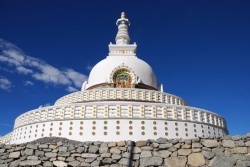Difference between revisions of "Stūpas"
| Line 1: | Line 1: | ||
[[File:Shanti_Stupa012.jpg|thumb|250px|]] | [[File:Shanti_Stupa012.jpg|thumb|250px|]] | ||
| − | Stupa comes from the Sanskrit word stūp meaning ‘to heap’ and refers to a characteristic Buddhist monument. The Pāḷi equivalent is thūpa.After the Buddha’s passing and cremation, his ashes were divided into eight parts and each was interned under a large hemispherical earthen mound, as was the custom of the time. People would pay their respects to these mounds until eventually they came to be seen as symbols of the Buddha himself. In time the simple earthen mounds evolved into masonry structures, sometimes of great size and beautifully decorated. Today stūpas usually contain real or supposed relics of the Buddha or some great saint or articles used by them, and are common objects of devotion in all Buddhist countries. | + | Stupa comes from the [[Sanskrit]] [[word]] stūp meaning ‘to heap’ and refers to a [[characteristic]] [[Buddhist]] monument. The [[Pāḷi]] equivalent is thūpa.After the [[Buddha’s]] passing and [[cremation]], his ashes were divided into eight parts and each was interned under a large hemispherical earthen mound, as was the custom of the [[time]]. [[People]] would pay their respects to these mounds until eventually they came to be seen as [[symbols]] of the [[Buddha]] himself. In [[time]] the simple earthen mounds evolved into masonry structures, sometimes of great size and beautifully decorated. Today [[stūpas]] usually contain {{Wiki|real}} or supposed [[relics]] of the [[Buddha]] or some great {{Wiki|saint}} or articles used by them, and are common [[objects]] of devotion in all [[Buddhist]] countries. |
| − | The world’s largest such monument is the Jetavana Stūpa built by King Mahāsena towards the end of the 4th century in Anurādhapura, the ancient capital of Sri Lanka. This huge monument was originally 160 meters high; its present height up to the broken pinnacle is 70 meters and it has a diameter of 109 meters. It has been calculated that the Jetavana Stūpa contains 620 million bricks and weighs 657,000 tons. It sits on a huge paved terrace 173 meters square which could have accommodated up to 30,000 devotees on special occasions. See Doṇa. | + | The world’s largest such monument is the [[Jetavana]] [[Stūpa]] built by [[King]] Mahāsena towards the end of the 4th century in [[Anurādhapura]], the ancient {{Wiki|capital}} of [[Sri Lanka]]. This huge monument was originally 160 meters high; its present height up to the broken pinnacle is 70 meters and it has a diameter of 109 meters. It has been calculated that the [[Jetavana]] [[Stūpa]] contains 620 million bricks and weighs 657,000 tons. It sits on a huge paved terrace 173 meters square which could have accommodated up to 30,000 devotees on special occasions. See Doṇa. |
| − | The Stūpa, Its Religious, Historical and Architectural Significance, ed. by A. L. Dallapiccols, 1980. | + | The [[Stūpa]], Its [[Religious]], Historical and Architectural Significance, ed. by A. L. Dallapiccols, 1980. |
{{R}} | {{R}} | ||
[http://www.buddhisma2z.com/content.php?id=393 www.buddhisma2z.com] | [http://www.buddhisma2z.com/content.php?id=393 www.buddhisma2z.com] | ||
[[Category:Buddhist Terms]] | [[Category:Buddhist Terms]] | ||
[[Category:Stupas]] | [[Category:Stupas]] | ||
Latest revision as of 09:16, 7 September 2013
Stupa comes from the Sanskrit word stūp meaning ‘to heap’ and refers to a characteristic Buddhist monument. The Pāḷi equivalent is thūpa.After the Buddha’s passing and cremation, his ashes were divided into eight parts and each was interned under a large hemispherical earthen mound, as was the custom of the time. People would pay their respects to these mounds until eventually they came to be seen as symbols of the Buddha himself. In time the simple earthen mounds evolved into masonry structures, sometimes of great size and beautifully decorated. Today stūpas usually contain real or supposed relics of the Buddha or some great saint or articles used by them, and are common objects of devotion in all Buddhist countries.
The world’s largest such monument is the Jetavana Stūpa built by King Mahāsena towards the end of the 4th century in Anurādhapura, the ancient capital of Sri Lanka. This huge monument was originally 160 meters high; its present height up to the broken pinnacle is 70 meters and it has a diameter of 109 meters. It has been calculated that the Jetavana Stūpa contains 620 million bricks and weighs 657,000 tons. It sits on a huge paved terrace 173 meters square which could have accommodated up to 30,000 devotees on special occasions. See Doṇa.
The Stūpa, Its Religious, Historical and Architectural Significance, ed. by A. L. Dallapiccols, 1980.
